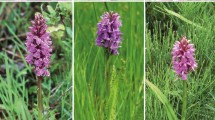Abstract
Morphological variation was analyzed in wild accessions and cultivars of the vegetatively propagated dioecious Coccinia grandis. Variations of 43 morphological characters, 19 qualitative and 23 quantitative traits, were analyzed among 40 female accessions, including 25 cultivars and 15 wild accessions. Multivariate statistical analyses were used to group accessions according to their morphological similarity. Principal component (PC) analysis revealed that the first three PCs accounted for 50% of the total variance, and differences among the accessions were evidenced principally in relation to fruit characteristics such as fruit weight, fruit length and the number of seeds in each fruit. Analysis of variance carried out in the entire germplasm revealed significant differences within the germplasm, whereas ANOVA carried out between the wild accessions and the cultivars proved the null hypothesis that there are no significant differences between the two groups, and differences were observed only in fruit characters that are targets of human selection. Principal component analysis, UPGMA cluster analysis and discriminant factor analysis revealed strong overlaps between the two groups indicating the ongoing process of evolution and selection in the species.


Similar content being viewed by others
References
Bawa KS (1980) Evolution of dioecy in flowering plants. Annu Rev Ecol And Sys 11:15–39
Bekele FL, Bekele I (1996) A sampling of the phonetic diversity in the international Cocoa gene bank of Trinidad. Crop Sci 36(1):57–64
Bisognin DA (2002) Origin and evolution of cultivated cucurbits. Ciencia Rural, Santa Maria 32(5):715–723
Casas A, Caballero J, Valiente-Banuet A, Soriano JA, Da′vila P (1999) Morphological variation and the process of domestication of Stenocereus stellatus (Cactaceae) in central Mexico. Am J Bot 86:522–533
Chambliss OL, Jones CM (1996) Chemical and genetic basis for insect resistance in cucurbits. Amer Soc Hort Sci 89:394–405
Efombagn MIB, Sounigo O, Nyasse S, Manzanares-Dauleux M, Eskes AB (2009) Phenotypic variation of cacao (Theobroma cacao L.) on farms and in the gene bank in Cameroon. J Plant Breeding Crop Sci 1(6):258–264
Engle LM, Altoveros NC, Geal GG, Phanmaliving K, Xaygnalis P, Opena RT (1998) Domestication of Coccinia grandis: an underutilized vegetable species in Lao PDR. Philipp J Crop Sci 23(1):73
Harlan JR (1975) Crops and man. Foundation for modern Crop Science. American Society of Agronomy, Madison
Harlan JR (1992) Origins and processes of domestication. In: Chapman GP (ed) Grass evolution and domestication. Cambridge University Press, Cambridge, pp 159–175
Imbumi MD (2004) Coccinia grandis (L.) Voigt. In: Grubben GJH, Denton OA (eds) PROTA 2: Vegetables/Legumes. PROTA, Wageningen
IPGRI (2003) Descriptors for melon (Cucumis melo L.). International plant genetic resources institute, Rome
Johns T (1989) A chemical–ecological model of root and tuber domestication in the Andes. In: Harris DR, Hillman GC (eds) Foraging and farming: the evolution of plant exploitation. Unwin Hyman, London, pp 504–519
Kölling MG, Madsen S, Christiansen J (2000) A phenetic analysis of morphological variation in Citrullus lanatus in Namibia. Genet Resour Crop Evol 47:385–393
Lins Neto EMF, Peroni N, Maranhao CMC, Maciel MIS, Albuquerque UP (2011) Analysis of Spondisa tuberosa Arruda (Anacardiaceae) in different landscape management regimes. A process of incipient domestication. Environ Monit Assess 2280-87
Lower RL, Edwards MD (1986) Cucumber breeding. In: Bassett MJ (ed) Breeding vegetable crops. AVI, Connecticut, pp 173–207
Mallick MFR, Masui M (1986) Origin distribution and Taxonomy of melons. Sci Hortic 28:252–261
Mckey D, Elias M, Pujol B, Duputie A (2010) The evolutionary ecology of clonally propagated domesticated plants. New Phytol 186:318–332
Morimoto Y, Maundu P, Fujimaki H, Morishima H (2005) Diversity of land races of the white flowered guard (Lagenaria siceraria) and its wild relatives in Kenya: fruit and seed morphology. Genet Resour Crop Evol 52:737–747
Perry LM (1980) Medicinal plants of east and south east Asia, attributed properties and uses. MIT Press, London
Pickersgill B (2007) Domestication of plants in the Americas: insights from mendelian and molecular genetics. Ann Bot 100:925–940
Purseglove JW (1968) Tropical crops: dicotyledons. Longman, London
Sing AK (1990) Cytogenetics and evolution in the Cucurbitaceae. In: Bates DM, Robinson RW, Jeffrey C (eds) Biology and Utilization of the Cucurbiataceae. Cornell University, Ithaca, pp 10–28
Sneath PHA, Sokal RR (1973) Numerical taxonomy. W. H. Freeman and company, San Francisco
Waller DM (1988) Plant morphology and reproduction. In: Doust JL, Doust LL (eds) Plant reproductive ecology: patterns and strategies. Oxford University Press, New York, pp 203–227
Whitaker TW (1974) American origin of the cultivated cucurbits. Ann Missouri Bot Gard. 34:101–111
Whittakar TW, Davis GN (1962) Cucurbits: botany, cultivation and utilization. Interscience, Newyork
Zohary D (2004) Unconscious selection and the evolution of domesticated plants. Eco Bot 58(1):5–10
Acknowledgment
The authors thank Dr. Asha Latha S. Nair, Head of the Department of Botany for the facilities provided.
Author information
Authors and Affiliations
Corresponding author
Rights and permissions
About this article
Cite this article
Shaina, T.J., Beevy, S.S. Morphological variation and evolutionary significance of Coccinia grandis (L.) Voigt: an under-exploited cucurbitaceous vegetable crop. Plant Syst Evol 298, 653–659 (2012). https://doi.org/10.1007/s00606-011-0574-4
Received:
Accepted:
Published:
Issue Date:
DOI: https://doi.org/10.1007/s00606-011-0574-4




